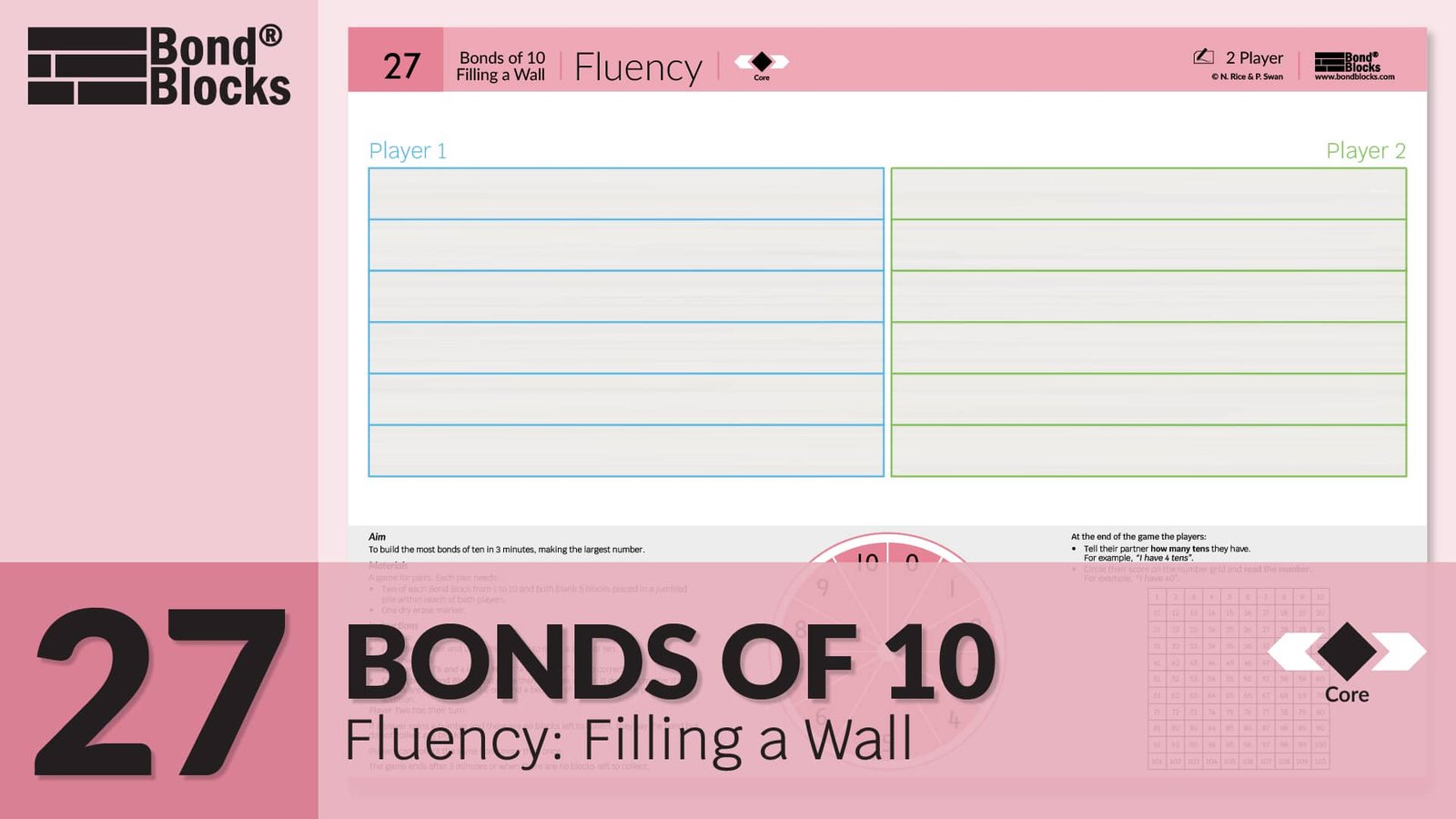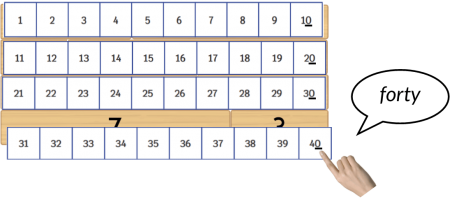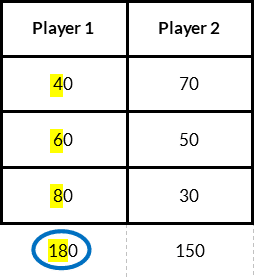27) Fluency
Bonds of 10: Filling a Wall

Mathematics
Develop fluency with two-part bonds of 10.
Develop the concept of counting in ten, starting at zero, as repeatedly adding ten.
Language
- addition as “and”
- equals as “is”
Core Activity Observations
Language “ty” verses “teen”
Listen carefully to students’ pronunciation of “ty” at the end of the game when students tell their partner how many tens they have and circle their score. For example, “I have four tens. I have forty“.
- The “ty” means groups of ten. For example, four tens.
- This is different to “teen” which means ‘add one ten’. For example, “fourteen” is ‘four add one ten’.
Assist students who incorrectly say ‘teen’, instead of ‘ty’ by completing the following activity for individual students. This activity focuses on connecting the number name “forty”, the written number ’40’ and the quantity (Bond Blocks). You will need:
- Bond Blocks made into rows of ten whilst playing Bonds of 10: Fluency Filling a Wall .
- One Number Board: Starting At One. Click to download.
- One pair scissors.
- One pencil.
Instruct the student to:
- Place the Bond Blocks they made into bonds of ten whilst playing Bonds of 10: Fluency Filling a Wall on top of the Number Board Starting at One.
- Count aloud by ten as each row is placed on the Number Board. Ensure the decade number is said correctly.
- Repeat the statement made in Bonds of 10: Fluency Filling a Wall saying the greatest number covered by the blocks. For example, “I have 4 tens. I have forty”.

- Slide the Bond Blocks off the Number Board, keeping the blocks in rows.
- Cut the previously covered rows of the number board into horizontal strips. Place these strips on top of the Bond Blocks the student had made into bonds of ten when playing the Bonds of 10: Fluency Filling A Wall game.
- Count aloud by tens pointing to each multiple of ten of the number board as it is said. Listen for “ty”.

- Count again by tens whilst using a pencil to underline each zero on the number board as the “ty” is said.
- Define “ty” as groups of ten.

Differentiation
A little easier
Scaffold: counting order
Instead of placing the blocks in a jumbled pile ask the student to first build a wall of 10. Play with the wall assembled before playing with blocks jumbled.

Working Memory Support: desk visual
New activity coming soon. Images and download to be updated.
Place this desk visual in front of students who tend to count by ones. Encourage them to use this to help them make the representation instead of counting. Initially practise making the numbers in counting order. Once students are confident, practise making the numbers called out in random order.

Note: If students use their fingers in a different (but typical) way to make the subitised number do not make them change. For example, many students make the 3-part of 8 using their thumb, index and tall finger. The important thing is that they make the number the same way each time, using one hand of five and the other hand with consecutive fingers ‘up’, without counting.
Recall Practice: subitised fingers
New activity coming soon. Images and download to be updated.
Pocket Dice Activity
The teacher rolls a pocket dice.
The student:
- Makes this amount using fingers in a subitised way. Students must use on hand of five to practise making five-plus bonds and related bonds of ten. Students are not practising doubles. For example, 8 as 4 and 4.
- Says the matching bond. For example, “8 and 2 is 10”
Tip: Don’t worry if students say the bond related by the commutative property instead of the one that matches the desk visual. Both are correct. For the example above this would be “2 and 8 is 10”. - Fills their frame with the matching number of counters.
Students do NOT clear the frame of counters after making each number. Instead, students alter the number of counters on the frame to make the new quantity. Doing this helps students learn about the comparative size of numbers. For example, 4 is 1 less than 5.
Click this link to download the pocket dice inserts and five frames. The blank insert is for teachers to call out one of the numbers (6 to 10) that is relevant for that student to focus on practising. Typically, students need more practice to develop fluency with 7 and 8.
A little harder
Calculate: round total
Play for three rounds. Each player records their score as a two-digit number. The winning score in each round is circled. The player with the most number of rounds won is the overall winner.

Calculate: difference
Calculate the difference between each player’s score. The difference becomes the winner’s score.
Line up each player’s blocks to show the difference.
Play for three rounds. The player with the most number of rounds won is the overall winner.

To make this significantly harder students can add their winning differences for each round. The first to 100 wins. Students can use a calculator to add differences and check estimates to see how far away from 100 they are.
A lot harder
Calculate: overall total
Play for three rounds. Each player calculates the sum (total) of their three scores. The player with the greatest overall score is the winner.

This addition can be modelled with Bond Blocks. The blocks need to be defined as tens, not one. Using Bond Blocks to represent multiples of ten, not one, should only be done once students are fluent with addition and subtraction to 20. Once students do not regularly choose to use the blocks support addition and subtraction to 20, they will be ready to use them as multiples of ten to support addition and subtraction to 100.

Click to download the Number Expander to help students partition three-digit numbers using only tens, instead of the standard partition of hundreds, tens and ones. Flexible partitioning is essential to develop efficient calculating strategies.

Calculate: combined round total
Explore how each round adds to 11 tens, or 110.
Ask students to find the total of Player 1 and Player 2’s score after each round. (The answer is 110.) Discuss strategies used. Model adding each player’s score in tens. In the scoring table below each round would be calculated as
- 40 + 70 = 4 tens + 7 tens = 11 tens, which is 110 ones
- 60 + 50 = 6 tens + 5 tens = 11 tens, which is 110 ones
- 80 + 30 = 8 tens + 3 tens = 11 tens, which is 110 ones

This addition can be modelled with Bond Blocks. The blocks need to be defined as tens, not one. Using Bond Blocks to represent multiples of ten, not one, should only be done once students are fluent with addition and subtraction to 20. Once students do not regularly choose to use the blocks support addition and subtraction to 20, they will be ready to use them as multiples of ten to support addition and subtraction to 100.

Calculate: missing score
Ask one student in each pair to cover their score with their hand. State that you know the covered score without seeing it! Tell the student their score and then get them to remove their hand to prove you are right. Ask students how you know their score without seeing it. Model your mental calculation strategies aloud. Students repeat in pairs.

This can be modelled with Bond Blocks. The blocks need to be defined as tens, not one.

Progression
In the next activity students apply five plus bonds to addition. Go to
Activity 28
Bonds of 10: Fluency, Tic-Tac-Toe




